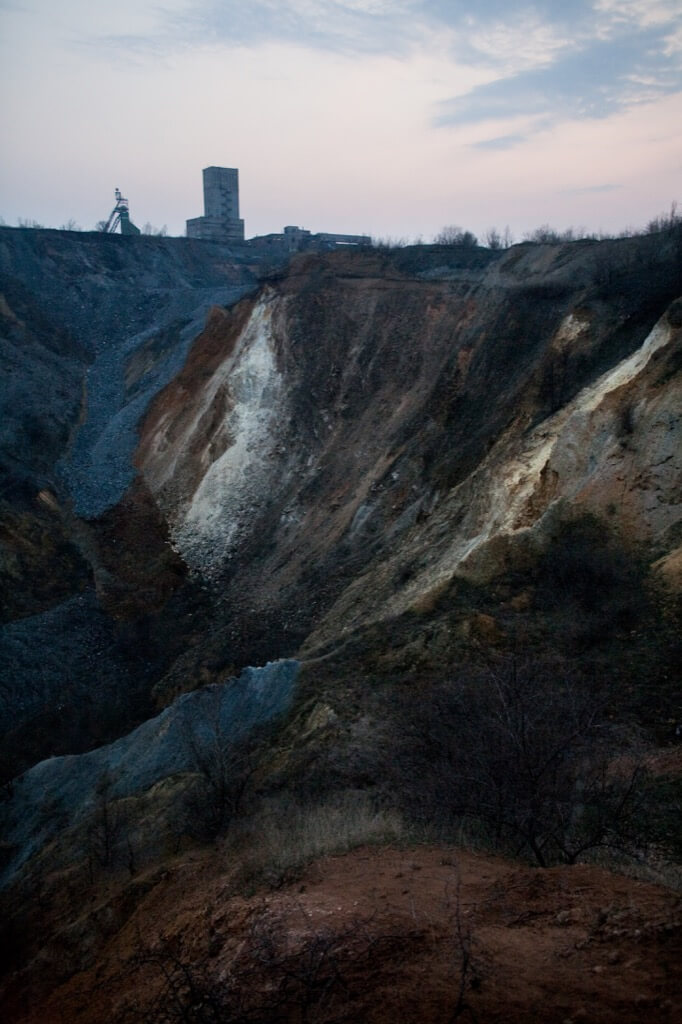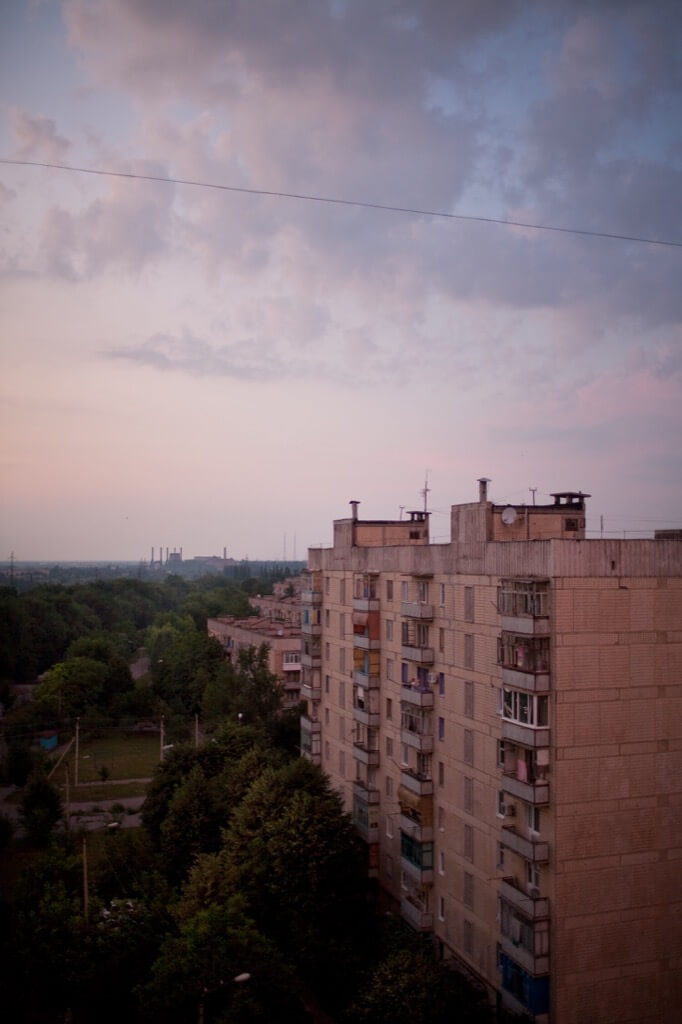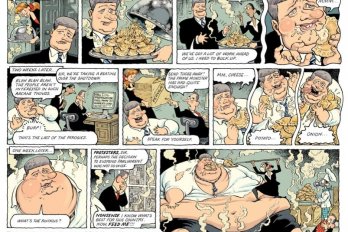On the eastern edge of Zhovti Vody, a city of 54,000 in the heart of the Ukrainian breadbasket, lies a gaping hole in the earth’s crust that once exposed rich deposits of uranium ore. The Nova mine is the last remaining one of three mines built in the 1950s, largely to supply the raw material for Soviet weapons. While the mine is now used only as a source of iron ore, the nearby hydro-metallurgical plant remains active, milling uranium mined 100 kilometres farther east. With the country’s growing appetite for nuclear energy, uranium is keeping Zhovti Vody alive even as it kills the people who live there.
Statistics are scarce, but a 2003 government report indicates that the city’s disability rate increased over the previous eight years by 20 percent, while it fell nationally by 18 percent. Most commonly, residents are suffering from congenital conditions and cancers, many of which have been conclusively linked to radiation. In another period of study, between 1993 and 2003, cancer doubled among men and rose by 1.3 times among women—faster than in other Ukrainian regions—while the city’s overall population declined by almost 1,000 per year.
Uranium and its radioactive daughters are toxic when inhaled or ingested. With embedded uranium, the risk of this is quite low, but mining and enrichment can lead to both air and groundwater contamination. Particular care needs to be taken with radioactive waste products. In Zhovti Vody, waste from the mill is made into a pulp, which is currently piped underground to a 250-hectare tailings pond on the city’s southern perimeter, close to wheat fields and cattle lands. Meanwhile, inactive dumps produce dust that officials say they control with plastic coating sprayed from helicopters, but residents complain of a metallic taste in their mouths in the summer. They might take refuge inside, but it isn’t any safer there. The concentration of radon in Zhovti Vody’s residential buildings is significantly higher than what is considered normal, likely due to radioactive tailings used to level the ground when the city was constructed.
Zhovti Vody is surrounded on three sides by giant tailings dumps, which in turn give way to farmland used to grow food and raise livestock.
Dima Pokil is one of many residents of Zhovti Vody suffering from cancer. He will be twenty-one years old at press time, if he lives that long.
The Nova mine is a legacy of the city’s Soviet-era uranium industry. A nearby mill remains active, processing ore mined in the Kirovograd region.
The radiation in local apartment blocks and houses is well above the levels considered safe by Ukraine’s government.
Sergei Shpetny was photographed in April and again in August 2009, a few months before he died of stomach cancer.
Sergei Shpetny, one of many Zhovti Vody residents sent to work on Chernobyl cleanup crews in 1986 (some suspect because the government believed they would be immune to the high levels of radiation), was diagnosed with stomach cancer two years ago. By last spring, he could no longer afford both his living expenses and his medical care. “How can we choose between two forms of life?” he asked. “We don’t, so we die.” Over bowls of borscht prepared by his wife, Ludmila, he spoke of his dwindling circle of friends and neighbours. “They die quietly. Wives try to wake up their husbands in the morning, and they’re dead.” That summer, Sergei’s tumour grew rapidly, eventually blocking his esophagus. He and Ludmila borrowed enough money for the recommended surgery, but it was too late. Five days after being released from the hospital, he died of starvation.
Yuliya Sidelnik’s disease has progressed more slowly, but this is not necessarily a blessing. Having survived since 1995 with sigmoid colon cancer—which she thinks is related to having worked with hazardous material at a secretive facility affiliated with the mill—she recently decided to stop making the trek for chemotherapy: she just doesn’t have the strength anymore. “I try to enjoy each day that I have left.”
Yuliya Sidelnik has survived with colon cancer for the past fifteen years.
Natasha Zhermel was diagnosed with kidney cancer when she was one year old. Four surgeries later, her parents no longer trust doctors in Zhovti Vody and are consulting specialists in Kiev.
Nelya Klepikova planted a garden in her apartment soon after she developed chronic myeloid leukemia. Since then, she has struggled to obtain the expensive medication she needs to survive.
“Kids this young do not get cancer,” doctors in Zhovti Vody said when Natasha Zhermel’s parents brought her to the hospital in 2007 with stomach pain. The next day, surgeons in the region’s capital discovered a Wilms’ tumour in her kidney. Recognition of the full scope and effect of the contamination has been slow across the board. In 2003, the government finally drafted its action plan for “Radioactive and Social Protection of the Population of Zhovti Vody.” The document called for an elaborate environmental restoration as well as the provision of new dwellings, better food, and improved medical assistance and social services. Political instability and a lack of money mean little has been accomplished since then.
When Nelya Klepikova was diagnosed with chronic myeloid leukemia eight years ago and couldn’t afford the prescribed medication, she lobbied hard for help (even writing a letter to President Vladimir Putin). Eventually, politicians who she says wanted to improve their image arranged for her participation in a sponsorship program run by the Swiss pharmaceutical company Novartis. After it was cancelled, she was one of eight people in the entire region to be accepted into another program, partially funded by the government. If it, too, is cancelled she’ll have to find a way to make her monthly 650 hryvnya ($85) disability pension cover a health care regime that costs 2,800 hryvnya a month. “I believe in God and science,” she says. “I have to believe that God will allow science to find a cure for cancer.”
Against the backdrop of widespread suffering, daily life goes on. People shop in local markets and fish; swim in the contaminated Yellow River; and watch a travelling circus.
Zhovti Vody was a very desirable place to live in the Soviet era. Built expressly to support the research and development of military technology, it boasted wide boulevards, trees, and special buildings like its Lenin Palace of Culture. Residents also had access to a variety of goods not available in other cities of the time. The city answered directly to Moscow, and it never appeared on any maps. “It was a secret city, and in a way it still is,” explains Nelya Klepikova. “If people knew, perhaps they’d do something.”
The catastrophe in Zhovti Vody hasn’t made international news. I first learned about it when, holidaying on the Crimean beach in Alushta, I struck up a conversation with a former resident who expressed surprise that I wasn’t afraid to be near him. Walking the streets of Zhovti Vody, as I did a year later, you wouldn’t necessarily know anything was wrong. As in many Soviet cities, the infrastructure is tired, but there are the usual signs of life. Teenagers listen to Russian pop music on the patio of their favourite pizza joint, while newly married couples pose in the park for wedding pictures. Men escape the heat at a local fishing hole, bringing their catch home to feed hungry families, and children cool off in the contaminated waters of the once-mighty Yellow River.
A Soviet fighter jet mounted at the city limits serves as a reminder of Cold War prosperity and its long-term costs.
Several new churches—Mormon, Evangelical, Jehovah’s Witness—have cropped up in Zhovti Vody in recent years. At informal religious gatherings, women pray for good health and plentiful jobs, hoping that one day they might have both.
In its heyday, the Soviet Union devoted a quarter of its gross economic output to the defence sector, which in turn employed almost one-fifth of the workforce. When the Cold War ended, Ukraine’s economy flatlined. Now that the country is eager to end its energy dependence on Russia, the uranium industry is picking up again. VostGOK State Enterprise, the national uranium producer, is involved in mining and milling the ore as well as in related industries, and as of 2008 generated 800 tonnes of uranium per year, making it the ninth-largest producer in the world. Its headquarters are in Zhovti Vody.






